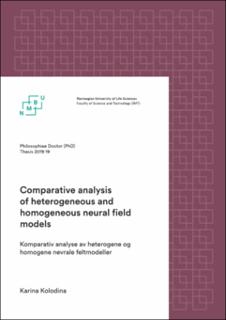| dc.contributor.advisor | Wyller, John | |
| dc.contributor.advisor | Ponossov, Arkadi | |
| dc.contributor.advisor | Oleynik, Anna | |
| dc.contributor.author | Kolodina, Karina | |
| dc.date.accessioned | 2022-12-19T08:55:12Z | |
| dc.date.available | 2022-12-19T08:55:12Z | |
| dc.date.issued | 2019 | |
| dc.identifier.uri | https://hdl.handle.net/11250/3038395 | |
| dc.description.abstract | The present thesis is devoted to the comparative analysis of heterogeneous and homogeneous neural field models. The motivation for this work stems from the fact that there is considerable interest in processes in neural tissue, which can underlie both natural and pathological neurobiological phenomena (e.g., orientation tuning in primary visual cortex, short term working memory, control of head direction, motion perception, visual hallucinations and EEG rhythms). The main aim of this thesis is to investigate the outcome of the analysis of a heterogeneous neural field model and its homogeneous counterpart. Another goal is to get more realistic dynamical models for the brain function which takes into account microscopic effects. Mathematically, this approach is formulated in terms of (a system of) nonlinear integro-differential equations. These models describe nonlinear interactions between neuron populations. They are used as a starting point to study traveling wave fronts, localized stationary solutions (bumps) and pattern formation.
The first part of the thesis consists of the introduction. Here we first give a short review of the neurophysical background. Secondly, we introduce the key mathematical objects of the present thesis, namely a neural field model of the Amari type and a 2-population homogenized neural field model. We also review the basic ideas of homogenization theory and the two-scale convergence method. Then we summarize the results and give ideas for future works.
The second part of the thesis consists of three papers. Paper I deals with the existence and linear stability of stationary periodic bump solutions to a neural field model of the Amari type. In Paper II and III we focus on 2-population homogenized neural field models where the cortical microstructure is taken into account in the connectivity strength. We study the existence and stability of localized stationary single bump solutions (Paper II). In Paper III we investigate pattern forming processes in the same neural field model. The key methods in the present study are a pinning function technique for the existence of bumps, spectral methods and properties, block diagonalization and the Fourier decomposition method in the stability assessment and numerical simulations.
We believe that the present thesis contributes to the understanding of the brain functions, both in normal and pathological cases. | en_US |
| dc.description.abstract | I denne avhandlingen utføres en komparativ analyse av heterogene og homogene nevrale nettverksmodeller. Motivasjonen for dette arbeidet er interessen for prosesser i hjernebarken, som kan være grunnlag for både naturlige og patologiske nevrobiologiske fenomener (for eksempel i orienteringsinnstilling i den primære visuelle hjernebarken, korttidsminne, kontroll av hoderetning, bevegelsesoppfattelse, visuelle hallusinasjoner og EEG-rytmer). Hovedformålet med denne avhandlingen er å analysere en heterogen nevral nettverksmodell og dens homogene motstykke. Et annet mål er å få mer realistiske dynamiske modeller for hjernefunksjonen, som tar hensyn til mikroskopiske effekter. Disse modellene er gitt som (et system av) ikke-lineære integro-differensiallikninger. Disse modellene beskriver ikke-lineære interaksjoner mellom nevronpopulasjoner. De brukes som utgangspunkt for å studere bølgeforplantning, lokaliserte stasjonære løsninger (bumps) og mønsterdannelse.
I introduksjonen presenterer vi en oversikt over den nevrofysiologiske bakgrunnen. Videre introduserer vi de matematiske modellene som er sentrale i denne avhandlingen, det vil si en nevral nettverksmodell av Amari- typen og en homogenisert 2-populasjon nevral nettverksmodell. Vi gjennomgår også grunnbegrepene i homogeniseringsteori og toskala konvergensmetoden. Deretter oppsummerer vi resultatene og fremlegger ideer for videre arbeid. Den andre delen av denne avhandlingen består av tre artikler. Artikkel I omhandler eksistensen og den lineære stabiliteten til stasjonære periodiske bump-løsninger i en nettverksmodell av Amari-typen. I artikkel II og III fokuserer vi på en homogenisert 2-populasjons nevral nettverksmodell, hvor mikrostrukturen i hjernebarken tas med i beregningen av konnektivitetsstyrken. Vi undersøker eksistensen og stabiliteten til lokaliserte stasjonære bump-løsninger (artikkel II). I artikkel III studerer vi mønsterdannende prosesser i den samme nevrale nettverksmodellen. De sentrale metodene i denne studien er en pinning-funksjonsteknikk for eksistens av bumps. Stabilitetsanalysen er gjennomført ved hjelp av spektral metoder , blokk diagonalisering og Fouriertransformasjon og numeriske simuleringer.
Vi mener at denne avhandlingen bidrar til forståelsen av hjernens funksjoner, både under normale og patologiske omstendigheter. | en_US |
| dc.language.iso | eng | en_US |
| dc.publisher | Norwegian University of Life Sciences, Ås | en_US |
| dc.relation.ispartofseries | PhD Thesis;2019:19 | |
| dc.rights | Attribution-NonCommercial-NoDerivatives 4.0 Internasjonal | * |
| dc.rights.uri | http://creativecommons.org/licenses/by-nc-nd/4.0/deed.no | * |
| dc.subject | Neural field models | en_US |
| dc.subject | Homogenization theory | en_US |
| dc.subject | Existence and stability of bumps | en_US |
| dc.subject | Periodic solutions | en_US |
| dc.subject | Pattern formation | en_US |
| dc.title | Comparative analysis of heterogeneous and homogeneous neural field models | en_US |
| dc.title.alternative | Komparativ analyse av heterogene og homogene nevrale feltmodeller | en_US |
| dc.type | Doctoral thesis | en_US |
| dc.relation.project | Norwegian University of Life Sciences and The Research Council of Norway: 239070 | en_US |

